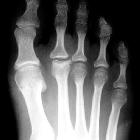Morbus Köhler-Freiberg














Freiberg disease, also known as Freiberg infraction, is osteochondrosis of metatarsal heads. It typically affects the 2 metatarsal head, although the 3 and 4 may also be affected. It can be bilateral in up to 10% of cases.
Epidemiology
It is most common in females aged 10-18 years (male to female ratio of 1:3).
Clinical presentation
Clinically they present with pain on weight-bearing with swelling and tenderness.
Pathology
The cause of Freiberg infraction is controversial and is probably multifactorial.
A traumatic insult in the form of either acute or repetitive injury and vascular compromise, perhaps due to an elongated 2 metatarsal, are the most popular theories, and as it is more commonly seen in women, particularly during adolescence, high-heeled shoes have been postulated as a possible causative factor.
Histologically, Freiberg infraction is characterized by the collapse of the subchondral bone, osteonecrosis, and cartilaginous fissures .
Radiographic features
Plain radiograph
These can be split into early and late features:
Early
- flattening and cystic lesions of the affected metatarsal head
- widening of the metatarsophalangeal joint
Late
- osteochondral fragments
- sclerosis and flattening of the bone
- increased cortical thickening
Some publications advocate the use of the Bragard staging classification , which requires two views/planes of the forefoot:
- I - metatarsal head flattening and decreased subchondral bone density
- II - metatarsal head sclerosis, fragmentation, and deformation, with cortical thickening
- III - metatarsophalangeal osteoarthrosis with intra-articular loose bodies
MRI
Early MR imaging findings include low-signal-intensity changes in the metatarsal head on T1-weighted images with increased signal intensity on corresponding T2-weighted and STIR images.
With disease progression, flattening of the metatarsal head occurs, and low-signal-intensity changes develop on T2-weighted images as the bone becomes sclerotic.
History and etymology
Albert H Freiberg (1868-1940), was an American orthopedic surgeon, who first described his eponymous condition in 1914 .
Differential diagnosis
On imaging consider
- normal variant: metatarsal head flattening is described in ~10% of the asymptomatic population
- fracture of metatarsal head or neck
- including subchondral insufficiency fracture
- lesser metatarsal head instability (only identified on MRI): due to plantar plate tear
See also
Siehe auch:
und weiter:

 Assoziationen und Differentialdiagnosen zu Morbus Köhler-Freiberg:
Assoziationen und Differentialdiagnosen zu Morbus Köhler-Freiberg:


